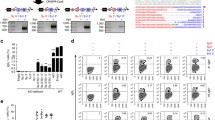Abstract
The CRISPR/Cas9 system, a defense mechanism naturally occurring in prokaryotes, has been recently repurposed as an RNA-guided DNA targeting platform and widely used as a powerful tool for genome editing. Here we describe how to modify the carboxy-terminal region, called Fragment crystallizable (Fc) region, of a murine monoclonal antibody by replacing the heavy chain constant exons with those from a teleost fish antibody by the CRISPR/Cas9 system. We outline optimal conditions for knockout and knockin mechanisms to edit the Immunoglobulin heavy chain (IgH) constant region gene locus in a murine hybridoma cell line. A chimeric mouse–fish monoclonal antibody can be successfully produced by hybridoma cell lines engineered according to this protocol.
Access this chapter
Tax calculation will be finalised at checkout
Purchases are for personal use only
Similar content being viewed by others
References
Köhler G, Milstein C (1975) Continuous cultures of fused cells secreting antibody of predefined specificity. Nature 256:495–497
Frenzel A, Hust M, Schirrmann T (2013) Expression of recombinant antibodies. Front Immunol 4:217
Ran FA, Hsu PD, Wright J et al (2013) Genome engineering using the CRISPR-Cas9 system. Nat Protoc 8:2281–2308
Ran FA, Hsu PD, Lin CY et al (2013) Double nicking by RNA-guided CRISPR Cas9 for enhanced genome editing specificity. Cell 154:1380–1389
Cong L, Ran FA, Cox D et al (2013) Multiplex genome engineering using CRISPR/Cas systems. Science 339:819–823
Bikard D, Jiag W, Samai P et al (2013) Programmable repression and activation of bacterial gene expression using an engineered CRISPR-Cas system. Nucleic Acids Res 41:7429–7437
Cheong TC, Compagno M, Chiarle R (2016) Editing of mouse and human immunoglobulin genes by CRISPR/Cas9 system. Nat Commun 7:10934
Pogson M, Parola C, Kelton WJ et al (2016) Immunogenomic engineering of a plug-and-(dis)play hybridoma platform. Nat Commun 7:12535
Khoshnejad M, Brenner JS, Motley W et al (2018) Molecular engineering of antibodies for site-specific covalent conjugation using CRISPR/Cas9. Sci Rep 8:1760
Gibson D, Young L, Chuang RY et al (2009) Enzymatic assembly of DNA molecules up to several hundred kilobases. Nat Methods 6:343–345
Heigwer F, Kerr G, Boutros M (2014) E-CRISP: fast CRISPR target site identification. Nat Methods 11:122–123
Qiu P, Shandilya H, D’Alessio JM et al (2004) Mutation detection using surveyor nuclease. BioTechniques 36:702–707
Urnov FD, Miller JC, Lee YL et al (2005) Highly efficient endogenous human gene correction using designed zinc-finger nucleases. Nature 435:646–651
Author information
Authors and Affiliations
Corresponding author
Editor information
Editors and Affiliations
Rights and permissions
Copyright information
© 2022 The Author(s), under exclusive license to Springer Science+Business Media, LLC, part of Springer Nature
About this protocol
Cite this protocol
Ametrano, A., Coscia, M.R. (2022). Production of a Chimeric Mouse–Fish Monoclonal Antibody by the CRISPR/Cas9 Technology. In: Verde, C., Giordano, D. (eds) Marine Genomics. Methods in Molecular Biology, vol 2498. Humana, New York, NY. https://doi.org/10.1007/978-1-0716-2313-8_19
Download citation
DOI: https://doi.org/10.1007/978-1-0716-2313-8_19
Published:
Publisher Name: Humana, New York, NY
Print ISBN: 978-1-0716-2312-1
Online ISBN: 978-1-0716-2313-8
eBook Packages: Springer Protocols




